Hurricane Helene Strikes Florida, Leaving Destruction and Power Outages
Hurricane Helene made landfall in Florida as a Category 4 storm, causing widespread damage and power outages. At least four deaths reported as the storm weakens over Georgia, threatening further flooding.

Hurricane Helene made landfall in Florida's Big Bend area on September 26, 2024, as a powerful Category 4 storm, causing significant damage and disruption across the southeastern United States. The Big Bend area, known for its unique coastline shape, experienced the full force of Helene's 140 mph winds, which fall within the 130-156 mph range typical of Category 4 hurricanes on the Saffir-Simpson Hurricane Wind Scale.
The storm's impact was immediately felt in the rural coastal communities near the mouth of the Aucilla River, an area rich in archaeological significance. Helene's arrival closely mirrored that of Hurricane Idalia, which struck the same region just one year prior, highlighting the area's vulnerability to intense storms.
As Helene moved inland, it left a trail of destruction. In Perry, Florida, buildings suffered extensive damage, with siding torn off and at least one home overturned. The storm's powerful winds and heavy rainfall led to widespread flooding, prompting rescue operations in Citrus County. Local authorities warned residents about the dangers of floodwaters, which can contain hazardous materials and pose significant risks.
The hurricane's effects extended far beyond the immediate landfall area. More than 3 million customers across the southeastern U.S. lost power, underscoring the storm's wide-reaching impact. Tragically, at least four fatalities have been attributed to Helene, including deaths in Florida, Georgia, and North Carolina.
As Helene progressed northward, it weakened to a tropical storm over Georgia. However, the threat of severe weather persisted, with forecasters warning of potential flash floods and mudslides in the Appalachian Mountains, some of the oldest mountains in the world. The storm's remnants were expected to bring heavy rainfall to Tennessee and Kentucky, raising concerns about further flooding in these areas.
The National Hurricane Center, established in 1965, continued to track Helene's movement and issue warnings. Hurricane hunters, who fly into storms to gather crucial data, played a vital role in monitoring the hurricane's intensity and path.
Helene's impact on transportation and daily life was significant. Airports in Tampa, Tallahassee, and Clearwater closed, while schools and universities across the region canceled classes. Emergency measures, including curfews and evacuations, were implemented in several states to ensure public safety.
This hurricane marks the eighth named storm of the 2024 Atlantic hurricane season, which typically peaks in September. The National Oceanic and Atmospheric Administration (NOAA), founded in 1970, had predicted an above-average season due to record-warm ocean temperatures. This forecast aligns with concerns about climate change potentially increasing hurricane intensity over time.

As communities begin to assess the damage and initiate recovery efforts, the importance of hurricane preparedness, including having emergency kits and evacuation plans, has once again been emphasized. The storm's impact on the Yucatan Peninsula and Cuba before reaching the U.S. mainland also highlights the wide-ranging effects of these powerful weather systems.
"This is one of the biggest storms we've ever had. We urge all residents to heed evacuation orders and stay safe as we work to assess and respond to the damage."
As the 2024 hurricane season continues, meteorologists and emergency management officials remain vigilant, monitoring potential storm development and preparing for future threats. The impact of Helene serves as a stark reminder of the destructive potential of hurricanes and the ongoing need for improved resilience and preparedness in coastal communities.


































